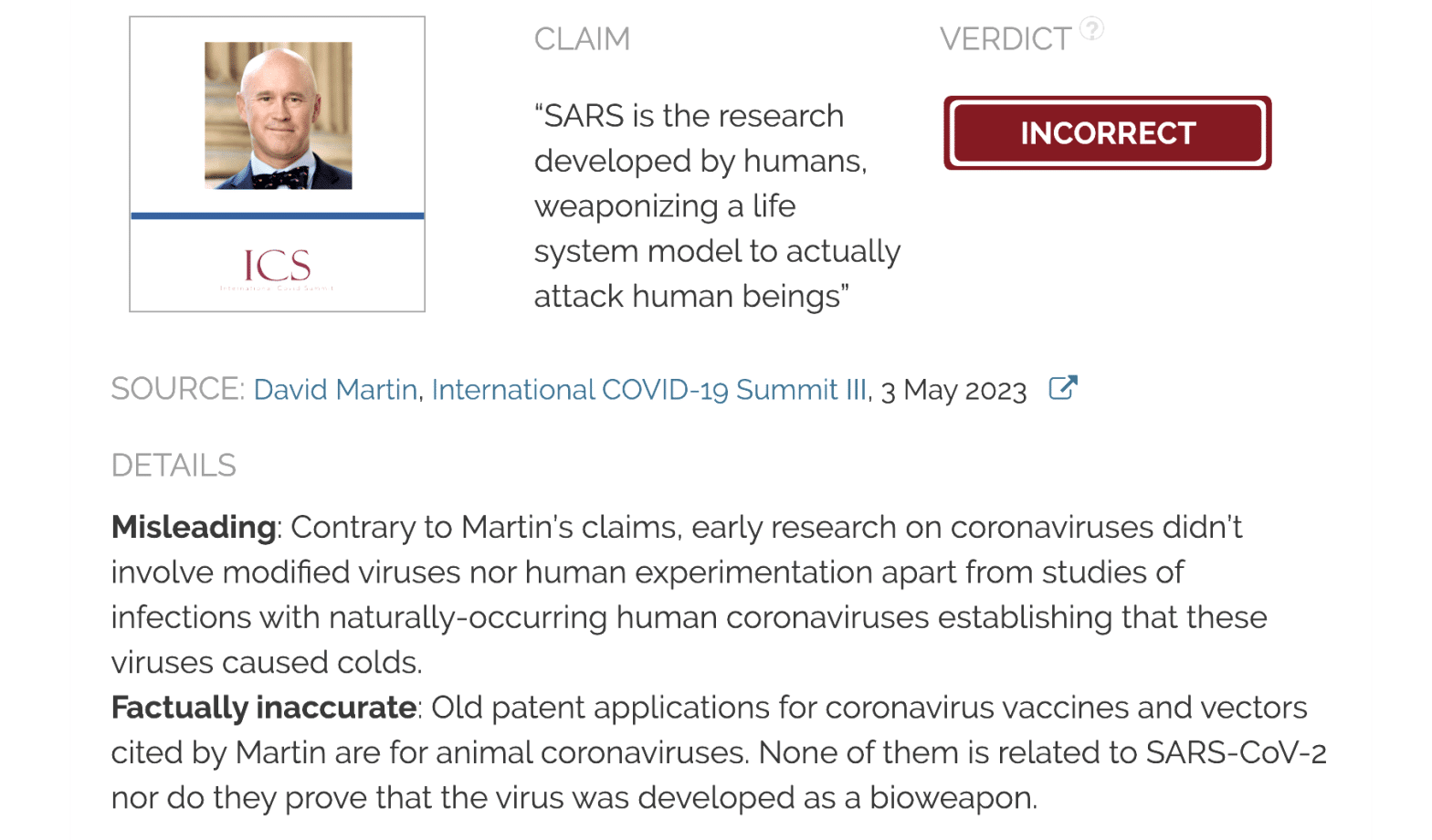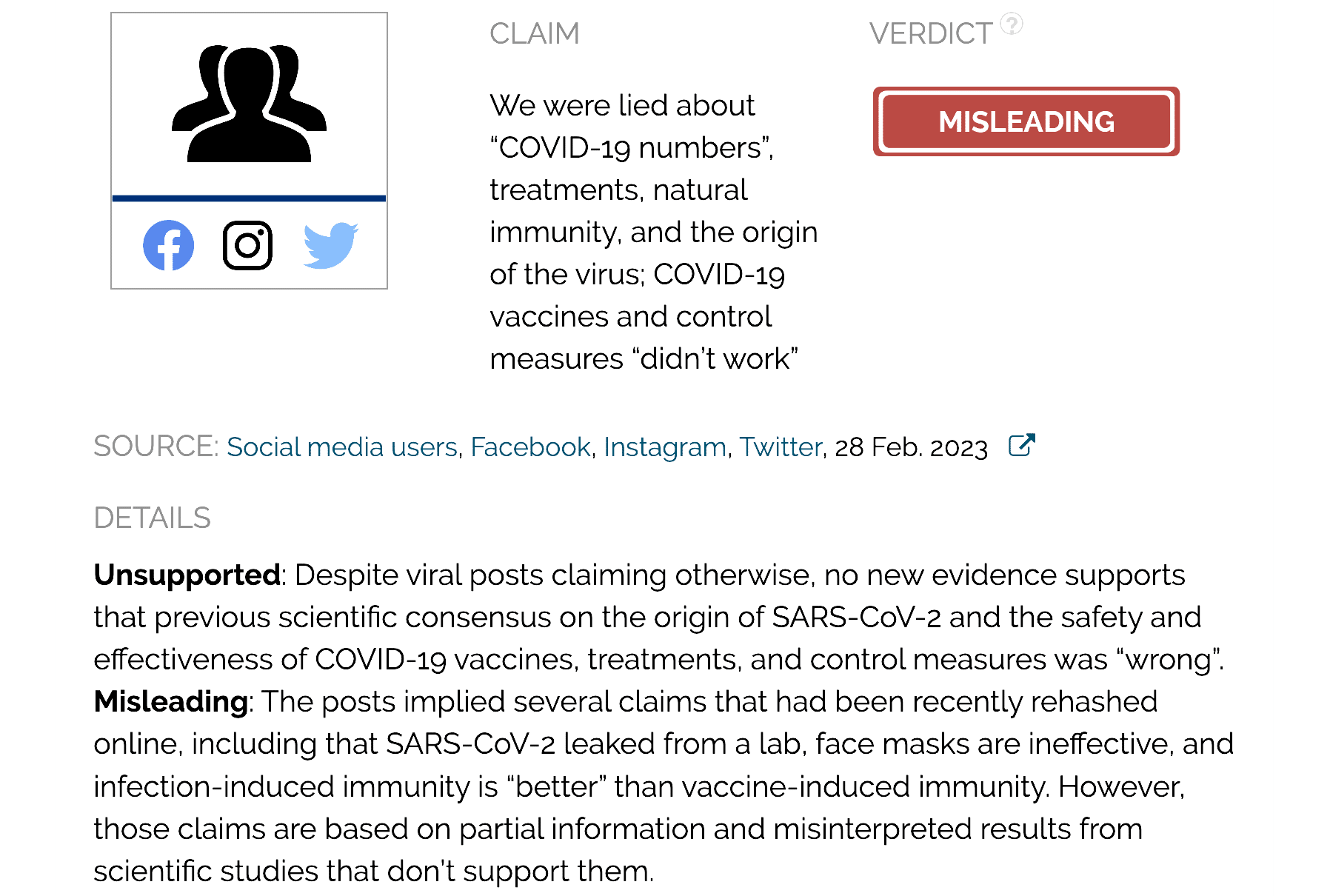- Health
Financial analyst David Martin misrepresents studies and patent applications to promote the baseless claim that SARS-CoV-2 was developed as a bioweapon
Key takeaway
At the moment, investigations are still underway to determine where SARS-CoV-2 originated and how it came to infect humans. Both the natural and lab leak hypotheses rely on circumstantial evidence that can’t prove nor disprove either theory. However, no credible evidence indicates that the virus was engineered. Based on prior disease outbreaks, the most likely hypothesis is that SARS-CoV-2 arose naturally and that zoonotic infections were the reason for the spread of the virus in humans.
Reviewed content

Verdict:
Claim:
“SARS is the research developed by humans, weaponizing a life system model to actually attack human beings”
Verdict detail
Misleading: Contrary to Martin’s claims, early research on coronaviruses didn’t involve modified viruses nor human experimentation apart from studies of infections with naturally-occurring human coronaviruses establishing that these viruses caused colds.
Factually inaccurate: Old patent applications for coronavirus vaccines and vectors cited by Martin are for animal coronaviruses. None of them is related to SARS-CoV-2 nor do they prove that the virus was developed as a bioweapon.
Full Claim
“SARS is the research developed by humans, weaponizing a life system model to actually attack human beings, and they patented it in 2002.”; “The intent was to get the world to accept a universal vaccine template, and the intent was to use coronavirus to get there”
Review
In May 2023, a video featuring financial analyst David Martin went viral on social media platforms, gathering millions of views on Facebook, Instagram, Twitter, and TikTok (examples here, here, here, and here). In it, Martin claimed that SARS-CoV-2 was an act of “premeditated domestic terrorism” and that the virus is a weapon that was engineered through decades of research with the objective of “get[ting] the world to accept a universal vaccine template”.
Martin’s 21-minute speech was only the beginning of a nine-hour event called “International COVID-19 Summit III” that was held in a room of the European Parliament in Brussels on 3 May 2023. As featured speakers, the event gathered a group of well-known COVID-19 misinformation actors, including Robert Malone, Ryan Cole, Byram Bridle, Christian Perronne, and Pierre Kory, president of the fringe medical group Front Line COVID-19 Critical Care Alliance (FLCCC).
A three-part video recording of the event was uploaded on Rumble, and video excerpts were widely spread online, aided by anti-vaccine, COVID-19 skeptic, and conspiracy groups and individuals who shared them. Among all the speakers, Martin’s speech attracted much attention online, receiving shares from FLCCC, the conspiracy website Infowars, and the anti-vaccine group Children’s Health Defense, as well as many social media users.
However, Martin’s claims are all unsubstantiated, contain numerous inaccuracies, and are based on a grossly distorted interpretation of historical coronavirus research that we will analyze in detail below.
The place where the summit took place and the summit’s use of the European Parliament’s logo was also misleading, lending a veneer of legitimacy to claims that the speakers had testified to the European Parliament. However, this wasn’t the case. Firstly, the event doesn’t appear in the list of official events on the European Parliament website.
Secondly, the event wasn’t held at the Hemicycle, where the 705 Members of the European Parliament (MEPs) gather during plenary sessions. Instead, it took place in one of the rooms available to MEPs, which was possible because the Summit was hosted by five MEPs, Cristian Terhes, Christine Anderson, Ivan Vilibor Sinčić, Francesca Donato, and Mislav Kolakušić, all of them known COVID-19 skeptics.
Thirdly, the European assembly clearly explained to CheckNews—a fact-checking section of the French newspaper Libération—that the European Parliament “didn’t organize or finance” this event, although some MEPs took part, “exercising their freedom of mandate”.
Claim 1 (Inaccurate and Misleading):
“coronavirus as a model of a pathogen was isolated in 1965. Coronavirus was identified in 1965 as one of the first infectious replicatable [sic] viral models that could be used to modify a series of other experiences of human condition.”
While it is unclear what Martin meant with “a model of pathogen”, the first coronavirus wasn’t isolated in 1965 but in 1936. That year, Beach and Schalm isolated the pathogen that caused avian bronchitis in newborn chickens, which symptoms had been described five years earlier, and determined that the disease was caused by a virus[1].
It still took 30 years to identify the first human coronavirus, 229E, discovered by Dorothy Hamre at the University of Chicago in 1962 when she analyzed tissue cultures of students with colds[2]. Around the same time, two research teams, one led by David Tyrrell in England and another by Ken McInstosh in the U.S., independently isolated two additional human coronaviruses, called B814 and OC43, respectively[3,4].
However, Martin’s claim that these viruses were immediately identified as a modifiable model is unsubstantiated because at that time, scientists didn’t know that they belonged to the same family. The term coronavirus was only introduced in 1968 when Tyrrell and June Almeida observed the viruses under the electron microscope and found that they all had their surface covered with characteristic spikes that resembled the sun’s corona.
Claim 2 (Inaccurate and Misleading):
“in 1966, the very first COV coronavirus model was used as a transatlantic biological experiment in human manipulation”; “And in 1967, the year I was born, we did the first human trials on inoculating people with modified coronavirus”
Martin accompanied these allegations with several scientific references. However, none of the studies he cited support such claims.
The first of those studies was conducted at the U.S. National Institutes of Health (NIH) and published in 1967—not in 1966, as Martin claimed. In it, McIntosh and colleagues collected nasopharyngeal fluid from NIH employees who had cold symptoms, isolated the viruses in them, and grew these viruses in laboratory cells and tissues[4].
The second study, published by Almeida and Tyrell also in 1967, described a method for detecting viral particles in organ cultures by electron microscopy. The authors observed that the recently identified 229E and B814 viruses were “morphologically identical” to the one that caused avian infectious bronchitis[5].
Finally, Martin cited a third study published by Bradburne, Bynoe, and Tyrell in 1967. This study is the only one that used human volunteers, who were inoculated with Hamre’s 229E virus isolates. The researchers observed that 13 of the 26 inoculated volunteers developed colds, providing the first experimental evidence that the new virus caused this condition[6].
From the information above, it is clear that Martin’s description is quite misleading, and these experiments can hardly be considered “a transatlantic biological experiment in human manipulation”. Furthermore, the claim is also inaccurate because none of these studies involved manipulated viruses.
Health Feedback tried to reach out to Martin for comment through the “Contact Us” section of his company’s (M-MCAM International) website, but the link was unresponsive. We will update this review if new information becomes available.
Claim 3 (Incorrect):
“Ironically, the common cold was turned into a chimera in the 1970s. And in 1975, 1976, and 1977, we started figuring out how to modify coronavirus by putting it into different animals, pigs and dogs.”
This claim demonstrates a gross misunderstanding of what coronaviruses are because it seems to suggest that there is only one coronavirus, that it can only cause colds, and that the only way it can get into animals is by “putting” it there. However, all these implications are incorrect.
The reference Martin cited to support his claim doesn’t show any human manipulation of coronaviruses. On the contrary, it is a 1992 study that used an unmodified rabbit coronavirus occurring in nature to model the disease in rabbits[7]. The researchers isolated the virus from moribund animals and injected it intravenously or intramuscularly in laboratory rabbits, observing that it caused myocarditis. This simple study found that coronavirus infection in rabbits might progress into heart muscle problems.
It is important to note that the term coronavirus doesn’t refer to a single virus as Martin seemed to suggest, but to a large family of viruses comprising more than 40 different viruses. Some of these viruses are specialized in infecting humans, while others specifically target a particular animal, such as dogs, cats, birds, or pigs. While coronavirus infections in humans primarily result in respiratory diseases, in other animals like pigs or dogs, they can cause gastroenteritis or other symptoms.
Hence, there is no link between SARS-CoV-2 and these animal coronaviruses because they are different viruses, each one with different characteristics that aren’t interchangeable.
Claim 4 (Incorrect):
“As a matter of fact, every publication on vaccines for coronavirus from 1990 until 2018, every single publication concluded that coronavirus escapes the vaccine impulse because it modifies and mutates too quickly for vaccines to be effective”
Martin’s claim is false because effective vaccines against coronaviruses were available years before the COVID-19 pandemic for several conditions affecting pets and livestock, as the U.K. Royal Society of Biology explains.
Ian Frazer, an immunologist and emeritus professor at the University of Queensland, told ABC News in 2020 that developing a vaccine against human coronaviruses is so challenging partly because the virus infects the upper respiratory tract. The problem is that the immune system isn’t particularly effective in this region, which means that a response induced by a vaccine will likely miss the target cells.
Claim 5 (Inaccurate):
“Dog breeders and pig farmers found that coronavirus created gastrointestinal problems, and that became the basis for Pfizer’s first Spike protein vaccine patent filed”; in 2002, the University of North Carolina Chapel Hill patented “an infectious replication defective clone of coronavirus […] Infectious replication defective means a weapon. It means something meant to target an individual but not have collateral damage to other individuals”
Searching patent databases for old applications containing the word coronavirus has proven a prolific source of conspiracy theories, all claiming to have found the smoking gun that the COVID-19 pandemic was planned or SARS-CoV-2 engineered. But as the McGill University’s Office for Science in Society explained in this article, none of these claims have any basis because those patents are unrelated to SARS-CoV-2.
Like many earlier such claims, Martin cited a patent application filed by Pfizer for “the very first spike protein vaccine for coronavirus” in 1990. Indeed, a patent (WO1993023422A1) protected the development of the first vaccine specifically targeting a coronavirus spike protein. However, this patent didn’t involve SARS-CoV-2 or any other human coronavirus. Instead, it targeted a cat coronavirus that caused highly lethal peritonitis in these animals.
Therefore, neither the specific patent nor the general strategy of targeting the spike protein—unsurprising considering that the spike protein forms the distinctive feature of the coronavirus family—suggest in any way that the SARS-CoV-2 virus was engineered, as Martin claimed.
Martin also cited another patent (WO02086068A2), submitted in this case by the University of North Carolina at Chapel Hill in 2002. Pointing out that this patent “mysteriously preceded SARS 1.0 by a year”, Martin suggested that this research could be the origin of not only SARS-CoV-2 but even the SARS-CoV-1 epidemic. He went even further by claiming that a term included in the patent, “infectious replication-defective clone”, means that the new virus is “a weapon” designed to target certain individuals. This is false.
Replication-defective means that portions of the viral genome essential for forming new viral copies have been removed, resulting in a viral vector that can no longer replicate. These replication-defective viruses are often used to introduce genetic material of interest into target cells by inserting it in the space left by the removal of the replication genes.
Martin wasn’t the first one to point at the patent of the University of North Carolina at Chapel Hill as evidence that SARS-CoV-2 is a bioweapon. But this claim is fundamentally baseless because the patent in question is entirely unrelated to SARS-CoV-2 and refers to a coronavirus that causes gastroenteritis in pigs.
Conclusion
In summary, Martin’s speech doesn’t provide the smoking gun for COVID-19 origin that he and others claimed to be. The alleged evidence presented is nothing but a list of misrepresented studies on early coronavirus research and old patent applications on animal coronaviruses all unrelated to SARS-CoV-2 or the COVID-19 pandemic.
None of the cited studies and patents suggests that the virus was engineered. In fact, some of Martin’s claims aren’t even new and have already been debunked. While there are still questions about whether the virus SARS-CoV-2 had infected humans through a naturally-occurring spillover event or a lab leak incident, there is simply no evidence to suggest that SARS-CoV-2 was developed as a bioweapon.
REFERENCES
- 1 – Beach and Schalm (1936) A Filterable Virus, Distinct from that of Laryngotracheitis, the Cause of a Respiratory Disease of Chicks. Poultry Science.
- 2 – Hamre et al. (1966) A New Virus Isolated from the Human Respiratory Tract. Experimental Biology and Medicine.
- 3 – Tyrrell and Bynoe (1965) Cultivation of a Novel Type of Common-cold Virus in Organ Cultures. BMJ.
- 4 – McIntosh et al (1967) Recovery in tracheal organ cultures of novel viruses from patients with respiratory disease. PNAS.
- 5 – Almeida and Tyrrell (1967) The Morphology of Three Previously Uncharacterized Human Respiratory Viruses that Grow in Organ Culture Free. Journal of General Virology.
- 6 – Bradburne et al. (1967) Effects of a ” New ” Human Respiratory Virus in Volunteers. BMJ.
- 7 – Lorraine et al. (1992) An Experimental Model for Dilated Cardiomyopathy after Rabbit Coronavirus Infection. Journal of Infectious Diseases.



